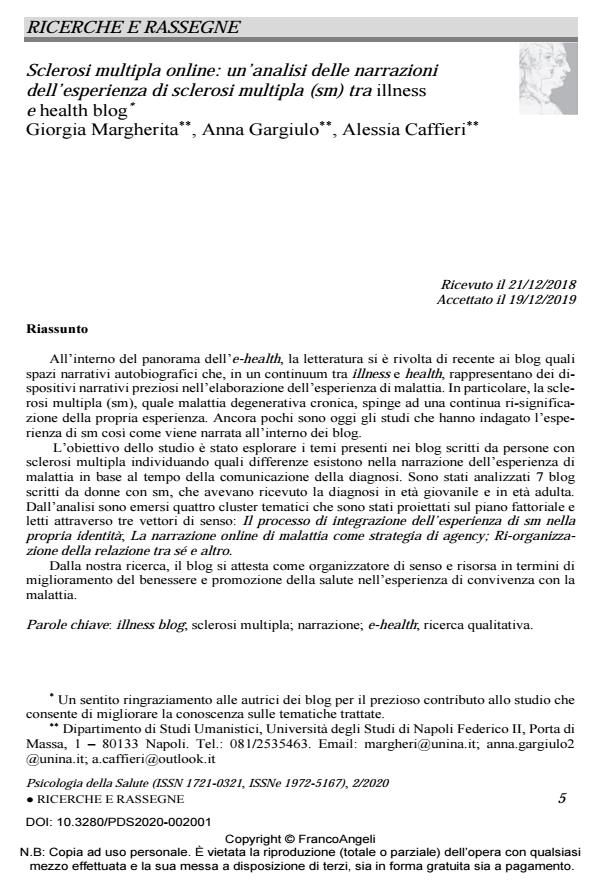Multiple sclerosis online: an analysis of the narratives of multiple sclerosis (ms) experience between illness and health blog
Journal title PSICOLOGIA DELLA SALUTE
Author/s Giorgia Margherita, Anna Gargiulo, Alessia Caffieri
Publishing Year 2020 Issue 2020/2
Language Italian Pages 20 P. 5-24 File size 308 KB
DOI 10.3280/PDS2020-002001
DOI is like a bar code for intellectual property: to have more infomation
click here
Below, you can see the article first page
If you want to buy this article in PDF format, you can do it, following the instructions to buy download credits

FrancoAngeli is member of Publishers International Linking Association, Inc (PILA), a not-for-profit association which run the CrossRef service enabling links to and from online scholarly content.
In the field of e-health, the research has recently focused on blog as narrative autobiographical spaces that, along the illness-health continuum, represent important narrative devices of illness experience. In particular, multiple sclerosis (ms), as degenerative chronic disease, induces to a continuous resignification of own experience. There are still too little studies about the experience of ms narrated in blog. The aim of the study is to explore themes in blog written by people with ms, identifying which differences exist in the narration of illness experience based on the time of communica-tion of diagnosis. Seven blog written by women with ms were analysed diagnosed in young adulthood and in adulthood. From the analysis four cluster emerged and subsequently project-ed on the factorial map and read through three sense vectors: The process of integration of the ms experience in the own identity; The illness online narration as a strategy of agency; Reorganization of the relationship between self and other. From our research the blog is seen as an organizer of meaning and resource in terms of improving well-being and health promoter in the experience of living together with the ms.
Keywords: Illness blog; multiple sclerosis; narration; e-health; qualitative research.
- The Psychological Health and Professional Well-being of Operators
Working with Forced Migrants in Italy: A Cross-sectional
Epidemiological Study Francesca Tessitore, Alessia Caffieri, Claudia Giordano, Giovanna Celia, Giorgia Margherita, in Current Psychiatry Research and Reviews /2024 pp.270
DOI: 10.2174/0126660822272705231121111221
Giorgia Margherita, Anna Gargiulo, Alessia Caffieri, Sclerosi multipla online: un’analisi delle narrazioni dell’esperienza di sclerosi multipla (sm) tra illness e health blog in "PSICOLOGIA DELLA SALUTE" 2/2020, pp 5-24, DOI: 10.3280/PDS2020-002001